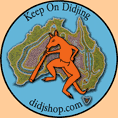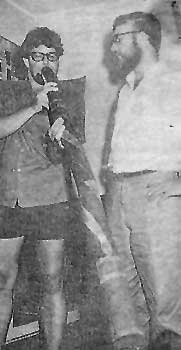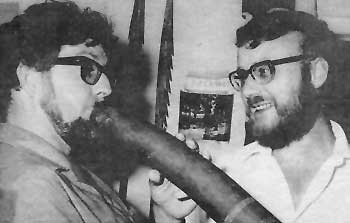| Discovering the Didgeridoo in the Sixties | ||
Didjshop.com thanks Willy Grimm for sharing this story on how he discovered the didgeridoo when he immigrated to Australia in the late sixties In march 1968 the vessel Galieo Gallilei docked into Melbourne harbour after 27 days on sea. I was one of the 1800 passengers migrating from Europe to Australia, and was 22 years of age. My interest was getting to know the 5th continent and maybe meet stone-age people of whom I’ve heard of. However for the last undertaking it seems, that I started at the wrong end, yet, it proved me right after only one week. It was Saturday night, walking along Beaumaris beach with the idea to dine in the first restaurant I shall come across. Well, it happened to be a restaurant called „The Didjeridoo“! After the meal a white musician appeared and played the strangest and most touching sounds I ever experienced. With my few sentences of English I tried to get as much information as possible on this hollow wooden log. Johnny “Didge“ Matthews was the man pulling the didjeridu and soon became my first teacher. He spent several years touring Aboriginal Australia, filming and getting to know some of their culture, The right end is the „Top End“ to experience Aboriginal culture and in June 1969 a Vanguard station-wagon was fully equipped and ready to depart Victoria, heading via Adelaide, Alice Springs to Darwin. A more than blessed happening was to meet Bob Cross at the Darwin-fare. He supervised a shop, selling Aboriginal handicraft. After one hour and an interesting chat he proposed to visit him in his Maningrida residence, Central Arnhemland. The track leading to this settlement only opened some years ago as a result of the increasing bauxite and timber industry. 400 Miles east of Darwin, stone country, mangroves and Aboriginal culture alive. For two weeks I observed and was amazed. Preparation for an initiation ceremony was in progress and also Yolngu people were exited. In the area of Cadellriver-crossing we encountered numerous rock and cave paintings, some of which we happened to be the first white spectators. A very strong feeling to share a similar sensation as the astronauts who, at the very same time set foot on the moon. It was here in Maningrida where I could obtain some very good didjeridus. The Maningrida Settlement, formed in 1957, is a trade and business control centre for tribes between the Liverpool and Blyth rivers, on the coast of Central Arnhem Land. The area was first explored in 1946 (which happens to be my year of birth). Australia arranged this expedition in collaboration with the National Geographic Society of America. Leading the expedition were the ethnologist Charles P. Mountford, and William E. Harney, an authority on Aboriginal life. Shortly after the publication of their report (2 books of 500 pages each), the functionaries of the Methodist and Protestant missions arrived, and tried to propagate their religious beliefs during just over a decade. These endeavours were abandoned, but did not fail to leave their traces. Maningrida is the homeland of the Gunavidji Tribe, although few still live there. Most moved westwards towards Darwin, or were forcibly relocated. The current Aboriginal population is composed of the Burera, Nakara, Gungorani, Gunwinggu and Gumanwurk tribes. Maningrida is also the home of our host Bob Cross, who familiarised us with the local people and their everyday life. During the day for example, we watched as George Nulumba Milpru (Kanalbingu) stripped huge pieces of bark for his paintings, cut them by hand, and laid them out weighted by stones to dry. Some of them were then passed on to the chief elder Mick Magani (Dijinang), and we were allowed to watch the next step in the processing. Mick sat in the shade of his branch-and-corrugated iron studio and rubbed the ochre together with plant juice, to provide the medium to paint the bark with traditional symbols. My favourite time was the period after sunset and into the night. Bob told us that preparations were under way for the circumcision ritual of three boys a few weeks later. There were small fires all over, and a didgeridoo droned in accompaniment to bilma (clapsticks) and singing. Dust rose from the dry ground, raised by the stamping feet of dancers, and the air was permeated with conversation, chit-chat and hearty laughter. With the gathering darkness, dark bodies merged into the dusk, and in the faint glow of the fires only eyes, teeth and white body-painting was to be discerned. It was an impressive experience for me to encounter the didjeridu in this traditional and ritual context. August 8th, 1969: We're sitting in the Skyvan aircraft, which will take us back to Darwin. We were leaving a bit of paradise on earth behind us. With every kilometre further that we flew, I felt my throat get stiff and my eyes grow moister. So there they were, these stone-age people of our millennium… and how blessed I felt for the opportunity to meet them. Nevertheless, the experience also left a bitter after-taste. As a whitefella, and especially as a Swiss, I was painfully aware of an indirect responsibility for the destruction of this idyll. The Nabalco company, 70% owned by Alusuisse (Swiss aluminium concern), was busy bulldozing enormous tracts of land, at the rate of 120 hectares a year, in order to extract the mineral base for aluminium. Just outside the Arnhem Land Reserve lies today the Kakadu National Park, where uranium ore is mined. Other large areas of forest have been sold for a song to Asian timber companies. Will the Aborigines, whose rightful ownership of East Arnhem Land was returned to them in 1976, really ever be able to make good their claim to have their land returned to them in its original condition?
In Darwin, it was pretty difficult fitting all our souvenirs in the car. We managed it though somehow, and set off on the next leg of the journey down along the Stuart Highway, and then eastwards with the Barkly Highway to Tennant Creek. In Camooweal we visited the caves at Nowraine, and shortly afterwards took the turn-off to Cloncurry, and then north until we reached Normanton in the Gulf of Carpentaria. The roads were unsurfaced again, and by the time we finished the 900 km to Cairns, we were pretty shaken. At that time, Kuranda was just the name of a place on the map, and not yet synonymous with David Hudson's Tjapukai Dance Theatre. We had now (unfortunately) left the outback behind. Our intention to drive through Cooktown and then as far as possible up into the northernmost nook of Australia was foiled because of heavy rainfall and poor roads. Nevertheless, we enjoyed the drive along the highways down the east coast, admiring the impressive scenery and views of the open sea. On Friday, 12th September 1969, we were back in Melbourne. A year-and-a-half had passed. Time for the next part of the adventure: the journey back over the Big Pond, the Pacific Ocean. We had decided to go back towards our homeland. I had eight didjeridus, 800 slides and countless impressions in my baggage, and the longing to share them with as many other Swiss people as possible. The ports en route were Melbourne – Sydney – Auckland – Fiji – Acapulco. We left the boat here with a rucksack apiece and spent the next four months crossing Mexico, the USA and Canada, and then went back down to Florida, where we boarded the same ship, which would carry us to Rotterdam. In the meantime, the ship had cruised right round the globe again! Then on via car to Switzerland, by way of Germany. Village followed village, and how cramped everything suddenly felt! June 1971, and I was back in Berne, filled with enthusiasm, at a time with little interest from Europeans in hearing details of Aboriginal culture or about the didjeridu. Despite holding slide-shows in schools, writing articles for newspapers and magazines, and generally propagating and demonstrating the didjeridu, there was little response. An approach to "Professor Termite" at the University of Berne, and my suggestion to the Australian Consulate that I could enhance their public events with a didjeridu solo, met a negative reaction. Well, how could it have been otherwise, with the attitude of the Australian government at that time towards "Black Australia"? I missed the sessions with Johnny "Didge" Matthews, listening and feasting on his pulsing rhythms. A stranger in my own home, a wanderer between two worlds. It was only ten long years later that the scene started to change. The world was shrinking, and exchanges were starting to happen between North and South, West and East. Musicians started to talk about overtones and circular breathing, and healers and therapists of chakras and meridians. Against a backdrop of booming high-tech euphoria, the counterbalance was becoming evident – "Less Is More", "Back To Nature" etc. Simultaneously the interest in the didgeridoo started to grow over the next twenty years. Read the Swiss Didgeridoo History as told by Willy Grimm Epilogue The year 2000 marked the closing of a circle for me. In February, I was asked by a hotel manager to make a didgeridoo presentation for an "Australian Week" in his establishment. Although we had arranged that it would happen after everyone had finished eating, I was suddenly asked to play during the main course. At first, I was reluctant, but then I remembered, how, exactly 32 years before, I first met the didge in a similar situation at the Didgeridoo restaurant in Beaumaris, Australia. I was touched, and grasped the opportunity to show my gratitude to "Johnny Didge" and the Aborigines. You might also want to read the Swiss Didgeridoo History as told by Willy Grimm |
||
|
Home | About Us | Checkout | Community | Help | Information | Shopping Didj Forum | Send a Didj Greeting Card | Guest Book |
||
| © Didjshop.com, 1993-. For rights reserved and granted see our Copyright notice. |


